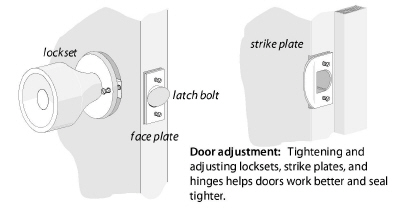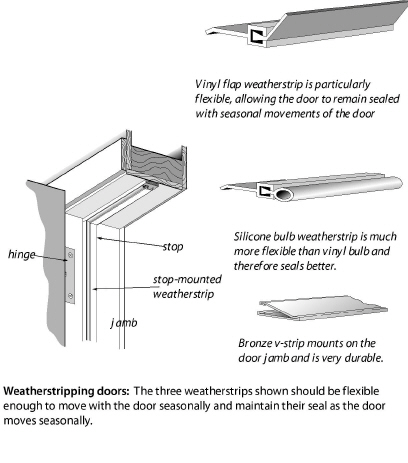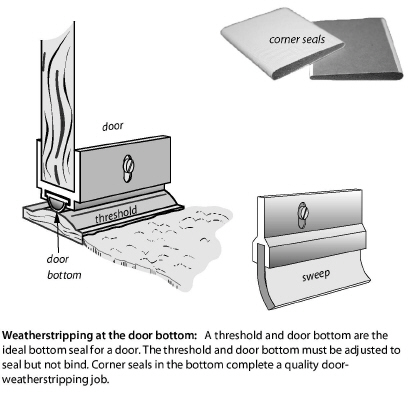
7.6 Door Replacement and Improvement
Exterior doors suffer a lot of wear because they function as entrances to buildings. Doors need adjustment or repair when they’re malfunctioning or damaged.
Install flashing around doorways according to the specifications in“Installing Replacement Windows” on page 231.
Door replacement may be completed as an efficiency measure if the cost is justified. Use Lead Safe RRP methods to ensure occupants and workers aren’t exposed to lead dust during door repair measures. See "EPA RRP Requirements" on page 45.
Observe the following standards when replacing exterior doors.
✓ Select the door with the lowest U-factor and the lowest air-leakage rating according to the NFRC label.
✓ Select no door glazing or door glazing with an appropriate solar heat-gain coefficient for the climate.
✓ Replace the existing door with an exterior-grade insulated door-blank or a pre-hung insulated door.
✓ All exterior replacement doors must have three hinges.
✓ Prepare the door opening carefully and thoroughly to create a continuous air barrier and water barrier using the air sealing and water sealing procedures as specified in “Window Replacement Specifications” on page 229.
✓ Adjust the new threshold for proper fit and minimal air leakage at the door bottom.
✓ Replacement doors in fire-rated assemblies must use sealants compatible with those fire-rated assemblies.
7.6.2 Door Adjustment and Repair
Door operation affects building energy-efficiency, security, and durability, so doors are sometimes an important weatherization priority. A leaky door may be an important comfort problem, and weatherstripping it can be a high-value energy conservation measure. Perform all door adjustment and repair in a lead-safe manner. See "EPA RRP Requirements" on page 45.
Evaluating Exterior Doors
Before weatherstripping a door, evaluate the door’s operation.
• Does the door bind or scrape against its jambs, indicating a need for hinge adjustment?
• Does the door close tightly and evenly against its stops or is there an uneven space between the door and stop when the door is latched?
• Can you move the latched door back and forth against its stops, indicating a need for latch adjustment?
• Can you move the open door up and down, indicating loose hinges?
Fixing Binding Doors
You can adjust binding doors by moving the door within its opening. Moving the top and middle hinges in, or moving the bottom and middle hinges out moves the door’s top latch-side corner upward and back toward the top hinge. Moving the top and middle hinges out drops the door down and moves the door away from the top hinge.
• If the hinges are loose, tighten the hinges and add longer screws if necessary. Longer screws can even move the door jamb a little, when necessary, if the screws penetrate the stud next to the door.
• If the gaps at the top latch-side corner are uneven, rotate the door in its opening by adjusting the hinges. Chisel the hinge mortises a little deeper or install cardboard shims between the hinges and door or jamb to move the door to create an even space around the door.
• If the house has settled and the opening is out-of-square, plane or power-sand the door so it closes without rubbing or binding against its jambs.
• If paint has built up and reduced the door’s operating gap, plane or sand off the excess paint. Planing and sanding are a last resort, so try the previous suggestions first.

Adjusting Latches and Stops
If a door won’t latch, inspect the door stops and weatherstripping to see if they’re binding. If there’s no obvious problem with the weatherstrip or stops, move the strike plate out slightly or use a file to remove a little metal from the strike plate to allow the latch to seat itself. The strike plate is mortised into the door frame that receives the latch.
✓ Tighten loose door knobs, face plates, and strike plates.
✓ If the door is warped and doesn’t fit well against its stops, adjust the stops by moving them against the door or planing them so door closes snugly against its stops.
✓ Move the strike plate to hold the door evenly against its stops if necessary. Use toothpicks to fill widened screw holes. Use longer screws if you have to move the strike plate.

Weatherstripping Doors
Consider these suggestions when weatherstripping doors.
✓ Use a durable stop-mounted or jamb-mounted weatherstrip to seal the door’s side jambs and head jamb.
✓ Seal the back of the weatherstrip to prevent air from leaking behind the weatherstrip.
✓ Install thresholds and door sweeps if needed to prevent air leakage at the door bottom. These air seals should not bind the door. Thresholds should be caulked underneath and on both sides of the door sill.
✓ Install corner seals to close the gaps at the bottom corners of the door jambs.
✓ Seal gaps between the stop and jamb with caulk.
✓ Install a door sweep if you don’t install a door bottom.
✓ The door must operate smoothly in the locked position after you weatherstrip it.
